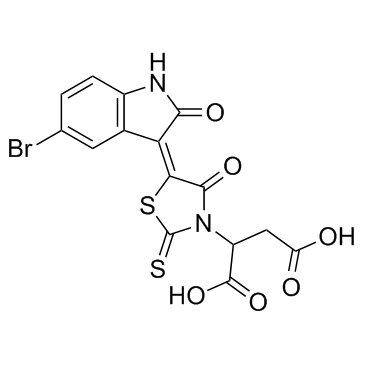| Description |
CID5721353 is an inhibitor of BCL6 with an IC50 value of 212 μM, which corresponds to a Ki of 147 μM.
|
| Related Catalog |
|
| Target |
IC50: 212 μM (BCL6)[1] Ki: 147 μM(BCL6)[1]
|
| In Vitro |
BCL6 is a member of the BTB/POZ family of transcription factors. CID5721353 (Compound 79-6) specifically inhibits BCL6 repressor activity. CID5721353 disrupts BCL6 transcriptional complexes and reactivates BCL6 target genes. CID5721353 can specifically kill primary human DLBCL cells. Fifteen of 19 BCL6-positive cases (79%) display greater than 25% loss of viability in response to CID5721353 at 125 or 250 μM[1].
|
| In Vivo |
In order to test whether CID5721353 (Compound 79-6) can perform as an anti-lymphoma therapeutic agent in vivo, whether it can penetrate tumors after parenteral administration through a distal site is determined. For this purpose 107OCI-Ly7 cells are injected into the right flank of 10 SCID mice and allowed to form tumors. Once tumors reach ~1.5 grams, animals are injected IP with a single dose of 50 mg/kg of CID5721353 in 10% DMSO or vehicle (10% DMSO) and sacrificed at 0.5, 1, 1.5, 3, 6, 12 and 24 hours after CID5721353 administration. Blood and tumors are harvested. Quantitative HPLC/MS analysis of the serum shows that CID5721353 levels peak (to 55 μg/mL, which is equivalent to a 122 μM concentration) one hour after the IP injection. CID5721353 also reaches its highest peak (24.5 ng/mg) at the 1-hour time point in the tumors, and after a sharp decline in levels, decreases gradually over 24 hours[1].
|
| Cell Assay |
Cell number and viability are determined by an EB/AO-based method and cells are cultivated in medium containing 80% RPMI and 20% human serum supplemented with antibiotics, L-glutamine and HEPES for 48 h. Pimary human diffuse large B cell lymphoma (DLBCL) cells are exposed to 125 and 250 μM of CID5721353 or control (DMSO) in triplicates. After 48 h of exposure viability is determined by using an ATP-based luminescent method and EB/AO. Specimens with 20% or higher loss of viability in the controls are discarded[1].
|
| Animal Admin |
Mice[1] Six to eight-week old male SCID mice are subcutaneously injected in the left flank with low-passage 107 human OCI-Ly7 cells. When tumors reach 1500 mm3 the mice are IP injected with 50 mg/kg of CID5721353 in DMSO (n=8) or DMSO (control, n=2). Blood and tumors are harvested at different time points after injection (30 min, 1 h, 1.5 h, 3 h, 6 h, 12 h and 24 h)[1].
|
| References |
[1]. Cerchietti LC, et al. A small-molecule inhibitor of BCL6 kills DLBCL cells in vitro and in vivo. Cancer Cell. 2010 Apr 13;17(4):400-11.
|
